New Hanafuda & Hwatu
Last updated: .
In the internet era there are now many Hanafuda brands that are produced on a small scale. Most of the production is outsourced to larger firms, and the designs aren’t made by the themselves. Thanks to the rise of crowdfunding, the variety of designs has greatly expanded from the traditional patterns.
Blank’s Art Project
Blank’s Art Project have created several Hwatu decks with custom art: Pebble (2016), Golden Toad (2018 & 2019 editions, crowdfunded on Korean site ‘wadiz’), and Pebble Film Edition (2019). They have also created custom promotional decks for Jeju beer (2017).

The five Bright cards of the Pebble Hwatu deck (2016).
© George Pollard, 🅭🅯🄏🄎
Hanafuda Hawaii
Produces two different decks: Hanafuda Hawai‘i Style (2009), and Hanafuda Nā Pua Hawai‘i (2016).
Hanafuda Hawai‘i Style recreates the traditional Japanese deck with bold artwork, including scores printed on the cards and with helpful icons to identify scoring combinations on the cards. In the rules given with the deck, there are not “5 Brights”, so the “4 Brights” are reproduced here:
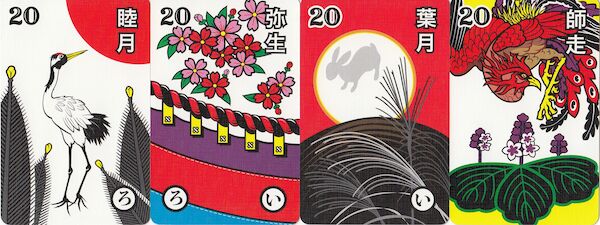
Hanafuda Hawai‘i Style bright cards.
© George Pollard, 🅭🅯🄏🄎
The cards of November show more of the style of the cards (note the ‘rain man’ is worth a mere 5 points with the Hawaiian rules):
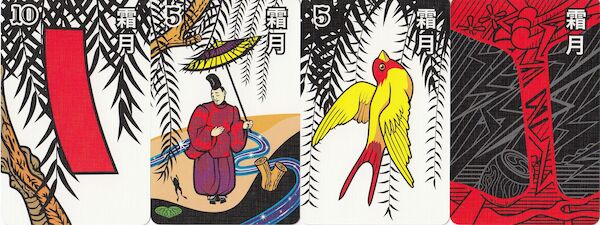
Hanafuda Hawai‘i Style November cards.
© George Pollard, 🅭🅯🄏🄎
Hanafuda Nā Pua Hawai‘i is probably my favourite of all the modern Hanafuda decks. It recontextualizes the game with the flora and fauna native to Hawai‘i, matching visual puns to the bold art of the Hawai‘i Style deck: in the month of March, for example, the cherry blossoms become ‘iliahi (sandalwood) flowers, and the curtain becomes the traditional kapa cloth.
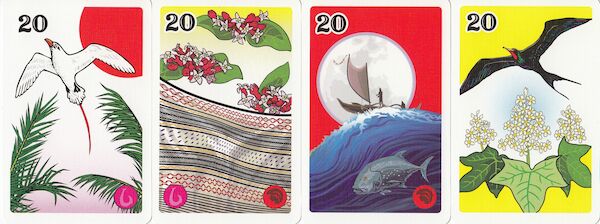
Hanafuda Nā Pua Hawai‘i bright cards.
© George Pollard, 🅭🅯🄏🄎
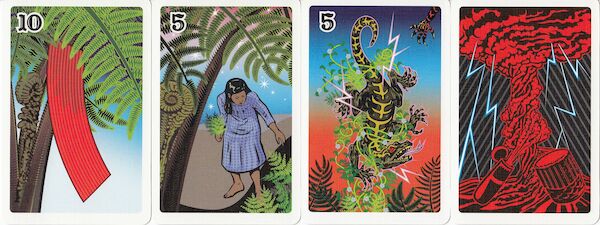
Hanafuda Nā Pua Hawai‘i November cards.
© George Pollard, 🅭🅯🄏🄎
Indianwolf Studios
Indianwolf have so far produced the HanamiHanafuda (2018) and SensuHanafuda (2019) decks, in poker-sized cards printed by Legends Playing Card Company. Both of these are available in a plain version, or one that has indices to aid new players.

The five Bright cards of the Hanami Hanafuda deck.
© George Pollard, 🅭🅯🄏🄎
After another successful Kickstarter campaign, Indianwolf also produced the NightParade deck (2020). The four cards of each month combine to form one wide tetraptych. The deck is themed upon traditional Japanese monsters (yōkai), and it also comes with rules for a new game called “Orochi”.

The five Bright cards of the Night Parade deck, and one joker.
© George Pollard, 🅭🅯🄏🄎

The tetraptych formed by the four s, all of which can be used as jokers.
© George Pollard, 🅭🅯🄏🄎
자매상점 (jamaistore)
Jamaistore produces ridiculously-cute cat & dog themed hwatu decks. Each of them comes with an additional six joker cards, appropriate to the theme. Both decks were crowdfunded on the Korean site ‘tumblbug’.

Jamaistore’s 냥투 (nyangtu, ‘meow fight’) deck (2016).
The name is a pun on hwatu with the Korean nyang meaning ‘meow’.
© George Pollard, 🅭🅯🄏🄎

Jamaistore’s 멍투 (meongtu, ‘woof fight’) deck (2017).
© George Pollard, 🅭🅯🄏🄎
Modern Hanafuda
Modern Hanafuda (2012) was one of the earliest Kickstarted Hanafuda decks. It was designed by Sarah Thomas, and the cards are decorated with bold flat colours and geometric patterns. The cards are larger and longer than normal playing cards.
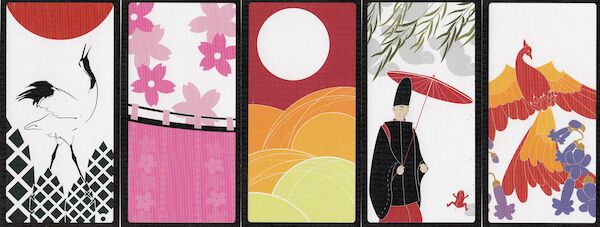
The 5 Bright cards of the Modern Hanafuda deck.
© George Pollard, 🅭🅯🄏🄎
NISHIKI 錦
This redesign by Hanako of estudio artes produced the only 3-way standard/Hanafuda/Kabufuda deck that I know of, which is printed on poker-sized cards. There is also a Hanafuda-only deck, in a traditional format.

The 5 Bright cards of the combination Nishiki Fuda deck. The cards from A–10 have Japanese numerals for use as Kabufuda cards.
© George Pollard, 🅭🅯🄏🄎

The 5 Bright cards of the standard Nishiki Fuda deck.
© George Pollard, 🅭🅯🄏🄎
용쟁화투 Yongjaeng Hwatoo
Yongjaeng Hwatoo produce hwatu decks in three varieties: Classic, Cute, and Style (pictured below). These designs have been produced in several editions over the years.

The five Bright cards of the Yongjaeng Hwatoo Style deck (2017).
© George Pollard, 🅭🅯🄏🄎
Cochae
Japanese paper design house Cochae produces Kokoyo (2019), a deck with bold, crisp visuals and faces on everything. The cards are coded by background colour so that Bright cards have a gold background, Tane have silver, etc.

The 5 Bright cards of the Cochae Kokoyo deck (2019). The backgrounds are a metallic gold colour, which doesn’t show up well here.
© George Pollard, 🅭🅯🄏🄎
Junior
Junior have produced a ground-up redesign of Hanafuda into a poker format deck, printed by USPCC. The first edition is called the Phoenix deck (2019). Each different type of Hanafuda card has a different background, and all are identified by suit marker indices, which helps to clarify the cards for new players.

The 5 Bright cards of the Junior Phoenix Hanafuda deck.
© George Pollard, 🅭🅯🄏🄎
To fill out the full 54 cards of a standard poker deck, there are an additional 6 ‘bamboo’ cards including an additional Fuji Bright and second Oni card:These were inspired by the extra cards of the Universal deck.
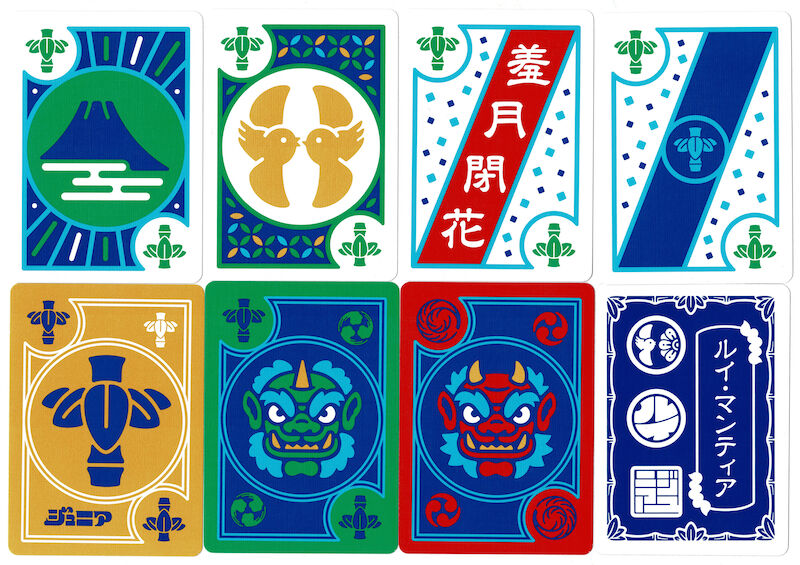
The additional ‘Bamboo’ suit of the Phoenix deck, as well as the lightning card (featuring an oni) and an advertisement card.
© George Pollard, 🅭🅯🄏🄎
After the successful completion of the Kickstarter campaign in 2020, two more Junior decks were produced: Dragon and Tiger.
Pixel Hanafuda
Ryan Sartor has produced Pixel Hanafuda, which is currently available from The Game Crafter. The art is inspired by 8- & 16-bit video games, and the cards are designed with a 29×44 pixel grid. The full set includes two decks, one each with black and red borders, and an additional 12 cards with “palette-swapped” colours, as an homage to the artistic techniques of the era. These additional cards can be used to play or invent new games; the set also includes rules for three original games invented by Ryan.

The five Brights of the Pixel Hanafuda deck.
© George Pollard, 🅭🅯🄏🄎

Some of the palette-swapped cards from the Pixel Hanafuda deck.
© George Pollard, 🅭🅯🄏🄎
Tetsufuda
Tetsufuda (鉄札, 2020) is a train-themed deck created by Kotsu Shimbunsha, the publishing arm of the Japan Railways group (JR).
Each month features a real train that runs on a JR line, and the cards show attributes or specialities of the different regions of Japan. The four cards of each month combine to form a tetraptych.

The five Brights of the Tetsufuda deck.
© George Pollard, 🅭🅯🄏🄎
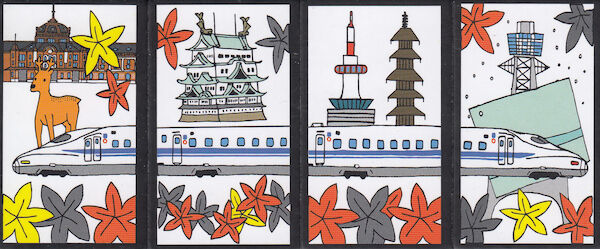
The maple cards feature the Nozomi Shinkansen of the Tōkaidō line.
© George Pollard, 🅭🅯🄏🄎
Heroku Hanafuda
Created by Heroku as a promotional item, this deck was designed by Lynn Fisher. The cards feature icons and imagery related to Heroku’s products.

The 5 Brights of Heroku’s deck.
© George Pollard, 🅭🅯🄏🄎
Tuhwa (투화)
This deck was designed by Korean design firm Utmost, and was first crowdfunded on wadiz. The name is a reversal of the standard Korean name Hwatu (화투). There are several editions of the deck available — v2 (2018) and v3 (2020) (“v1” appears to have been a small or private printing) — and each features different art based on traditional Korean art styles. The cards are much larger than those in a standard deck, and are made of plastic like other Korean decks.

The 5 Brights of the Tuhwa (v2) deck.
© George Pollard, 🅭🅯🄏🄎
Hanafuda Koi-Koi: Deluxe Edition
This deck was Kickstarted in 2023 by Pencil First Games. The art is by Vincent Dutrait.
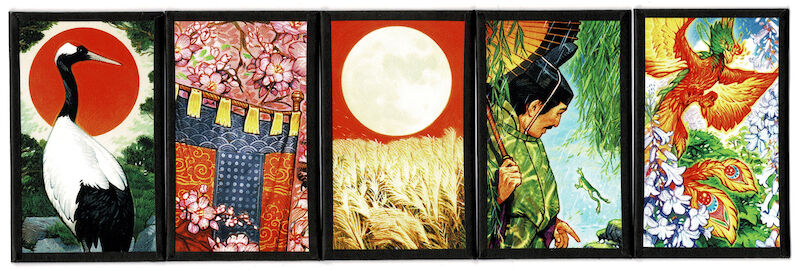
The 5 Brights of the Hanafuda Koi-Koi (deluxe edition) deck.
© George Pollard, 🅭🅯🄏🄎
Brownies Carta de Flor
In 2023, the video game company Brownies (now part of Nintendo itself) produced a deck that was manufactured by Nintendo. The cards are in an art-nouveau style.
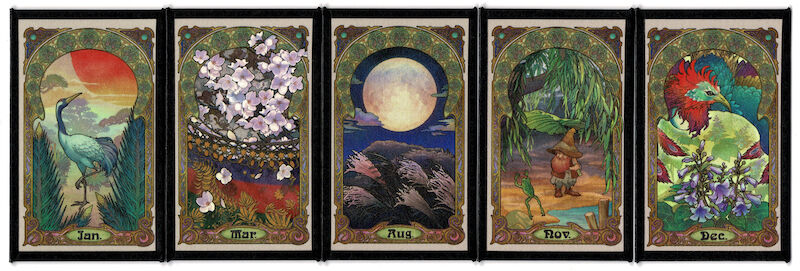
The 5 Brights of the Brownies deck.
© George Pollard, 🅭🅯🄏🄎
HWATU Flower Cards
These are redesigned version of Korean Hwatu cards by Spanish designer ‘blvr’. They can be purchased on their Etsy store.

The 5 Brights of the HWATU Flower Cards deck.
© George Pollard, 🅭🅯🄏🄎